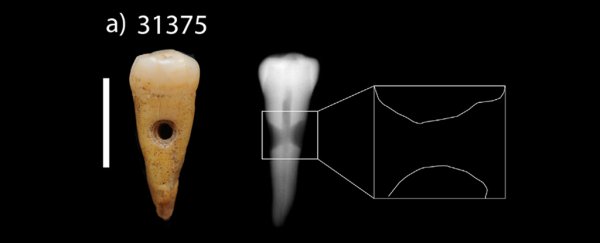The Neolithic settlement of Çatalhöyük in what is now Turkey has an enigmatic history, being one of the world's earliest urban centres.
The people who lived there had some interesting taste in adornment, and their excavated homes are renowned for the decorative use of animal teeth, horns and bones, along with the skulls of their dead, plastered over to resemble living faces. Now, it seems they also used human teeth to decorate their bodies.
Three teeth, found at the site dating back to between 6300 and 6700 BCE, show signs of deliberate modification for ornamental purposes, two of them very strongly. They are, according to the archaeologists, the first such ornamental teeth found in the Near East.
"The two confirmed pendants were likely extracted from the skeletonised remains of mature and old adults, carefully drilled, and worn for a variable period of time," they wrote in their paper.
"The rarity of such artefacts in the prehistoric Near East suggests a profound symbolic meaning for this practice and these objects, and provides new insights into the funerary customs and symbolic importance of the use of human body parts during the Neolithic of the Near East."
The three teeth all have a hole through the root. Two of the teeth - designated Tooth 31375, a permanent premolar, and Tooth 30567.x2, a permanent molar - were found in dwellings, the former among the remains of a collapsed wall, and the latter in a post-retrieval pit, where a post once stood to support a building.
The third, Tooth 30008, another permanent premolar, was found in a grave. Of the three teeth, this specimen shows the weakest evidence of deliberate drilling and ornamental use.
An international team of scientists led by Scott Haddow of the University of Copenhagen conducted macroscopic, microscopic and radiographic analyses of the teeth to determine how the holes were made. They also took silicone casts of 31375 and 30008 to examine microwear.
Both 31375 and 30567.x2 had clear drilling marks around the hole, which were both hourglass-shaped - consistent with biconical drilling, where the craftsperson drills from each side to meet in the middle. Both also showed signs of polish, and wear consistent with being threaded and maybe worn.
"The post-mortem smoothing, rounding and greasy appearance observed on the crowns and roots of both items is consistent with their use (suspension), and their contact with a relative soft contact material such as human skin or clothing," the researchers wrote.
"Overall, both drilled teeth present consistent wear patterns suggesting extended use as ornaments."
Tooth 30008 doesn't show the signs of drilling or wear seen on the other two teeth, and it's possible that the hole in it was actually a cavity.
Given that humans shed their baby teeth to grow adult teeth, the researchers noted, it's interesting that all three teeth are from adult individuals. And 31375 and 30567.x2 showed absolutely no sign of disease. This makes it likely that the teeth were removed post-mortem.
And, for all their penchant for animal bone interior design, animal teeth as beads are found pretty rarely at Çatalhöyük.
"Taken together, these observations militate against a solely aesthetic purpose for the practice of tooth modification observed at Çatalhöyük," the researchers wrote.
"Rather, these material choices - and their rarity overall - suggest a deeper symbolic value, the full meaning of which cannot be fully appreciated at present."
Neolithic tooth pendants, while rare, have been found in other parts of the world. A 2010 paper suggests that tooth pendants worn in Italy could indicate a strong personal link to the tooth's owner, or be used as an amulet or sign of affection.
For now, though, it remains a tantalising mystery.
The research has been published in the Journal of Archaeological Science: Reports.
